Traditional Korean markets began to multiply in the late 17th century as commerce blossomed. Initially part-time ventures, the markets became regular fixtures as the country modernized. Today, they range in size from modest alleyway markets to sprawling malls, but their character remains steadfast. Introduced here are Korea’s most well-known traditional markets.
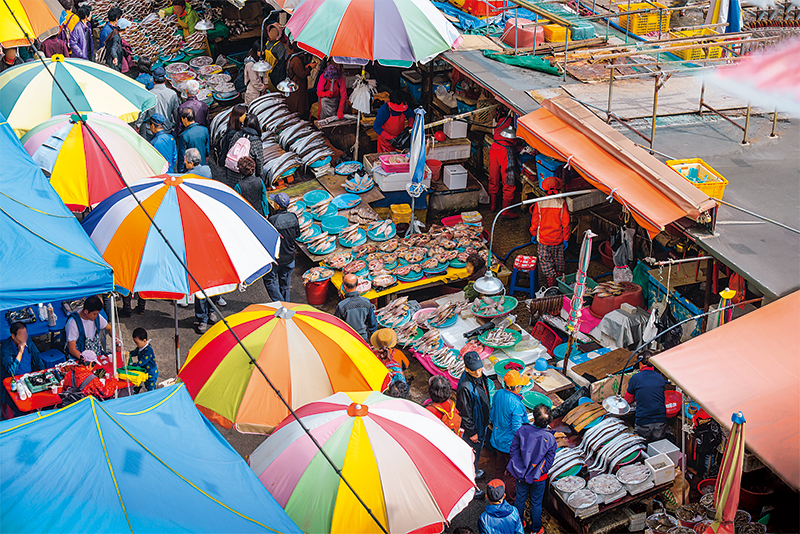
Jagalchi Market is Korea’s largest wholesale venue specializing in seafood. The market’s signature dish is hagfish (gomjangeo) marinated in spicy sauce and broiled on a grill. Its huge popularity has made the dish a fixture among pojangmacha (street food stalls) across Korea.
© Korea Tourism Organization
Exactly when the first market opened in Korea is uncertain. The History of the Three Kingdoms (Samguk sagi, 1145) holds that King Soji (r. 479–500), the 21st ruler of Silla, issued an order in 490 for a permanent market to be established in Gyeongju, the kingdom’s capital.
Korean markets of yesteryear had diverse names, depending on their locale or where the nearest district government office was situated. Most only opened every five days because Korea’s self-sufficient agricultural society had low demand for finished goods. There were few restrictions, so shoppers could choose from a broad array of merchandise and raw materials. Specialty markets also existed for goods such as livestock, grain, firewood, or medicinal ingredients. Among them was Yangnyeongsi, a market in Daegu selling medicinal herbs and other traditional remedies; it opened as early as 1658 and remains in operation today.
In the early years of the Joseon Dynasty (1392–1910), commercial restrictions curbed the number of markets. However, by the 17th century, the development of commerce and industry and the nationwide circulation of the Sangpyeong tongbo, a currency in use from 1678 to 1894, ripened conditions for the growth of markets. According to Essays on Rural Life and Economy (Imwongyeongjeji), a multi-volume encyclopedia written by Seo Yu-gu (1764–1845), a Silhak scholar devoted to the Korean Confucian social reform movement, there were more than 1,000 markets by the early 19th century.
As Korea modernized, the number of permanent daily markets increased across the country. By the end of the 1970s, amid rapid economic growth and rising household income, their number exceeded 700. According to the “Status of Traditional Markets Nationwide” published in 2022 by the Small Enterprise and Market Service, Korea now has 1,400 traditional markets, including permanent ones and the five-day variety. Having lost a big chunk of their business to superstores and online shopping malls, markets are now trying to regain their competitive edge by modernizing their facilities and operations.
NAMDAEMUN MARKET
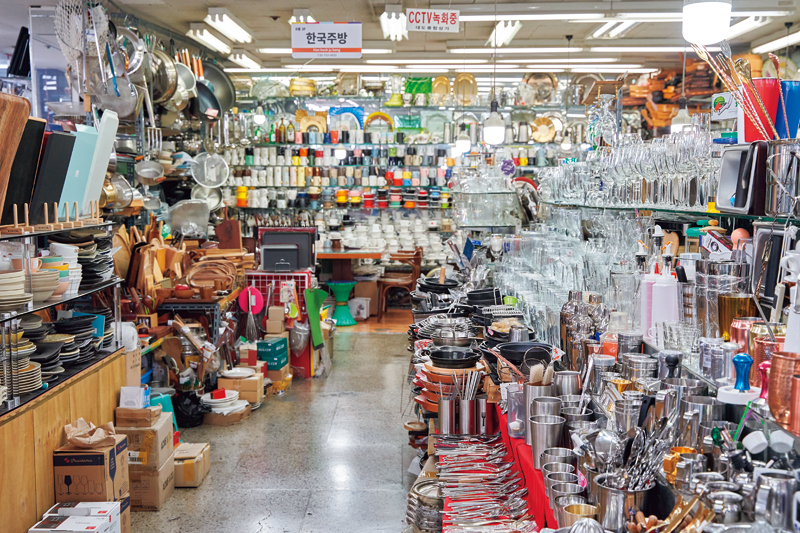
Kitchenware is among the 1,700 products sold at approximately 10,000 stores at Namdaemun Market in central Seoul. The market began in the 1400s and now covers several city blocks, attracting an average of 300,000 visitors daily.
© Seoul Tourism Organization
Located in Namchang-dong, Seoul, Namdaemun Market is the largest, busiest, and most comprehensive traditional market in Korea. It encompasses a maze of city blocks, which are closed to cars, and is considered a must-see attraction by many international tourists.
Namdaemun Market was established in the early 15th century and managed by government officials. In the 17th century, the market steadily swelled as merchants from provincial towns flocked to the capital to sell their goods. By the late Joseon period, Namdaemun Market was one of the three major markets in Hanyang (present-day Seoul).
Since 1950, the Korean War and fires have necessitated major reconstruction of the market. The latest version offers a myriad of items, including kitchenware, food, crafts, souvenirs, and household goods. The extensive children’s clothing section is a virtual world of its own, and hundreds of cafés, restaurants, and street food stalls keep shoppers well-fed.
DONGDAEMUN MARKET
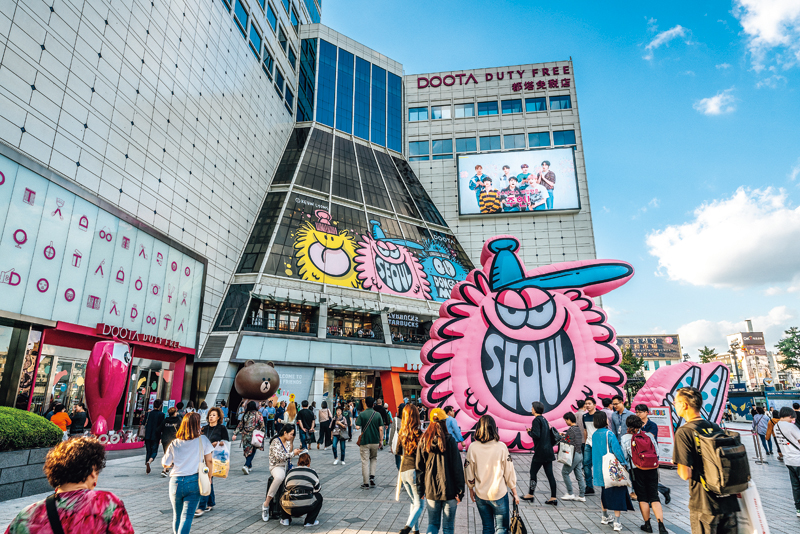
Dongdaemun Market became more modern with the establishment of large shopping malls such as Doota Mall and Migliore in the 1990s. Designated as a special tourism zone in 2002 by the Ministry of Culture, Sports and Tourism, the market’s daily foot traffic is estimated to be a staggering one million shoppers, diners, and entertainment seekers.
© Shutterstock
Dongdaemun Market has outgrown its original roots to become the largest wholesale and retail district in Korea. It has 31 shopping malls and tens of thousands of specialty shops and small manufacturers.
This area of Seoul covering 586,000 square meters was originally known as Baeogae Market. It flourished in the 18th century, with unregistered merchants selling commercially grown vegetables. During the Korean War, refugees settled in this area, and a clothing market formed as merchants turned war relief supplies into clothes to sell them.
In the early 1960s, Pyeonghwa Market opened, dealing with textiles and clothing, and in 1970, Dongdaemun Comprehensive Market opened its doors, offering fabrics, clothing accessories, and household goods for newlyweds. In 2002, the Dongdaemun Fashion Town Special Tourist Zone was established. Dongdaemun today is a large fashion district where traditional markets and modern shopping centers coexist.
DONGMYO FLEA MARKET
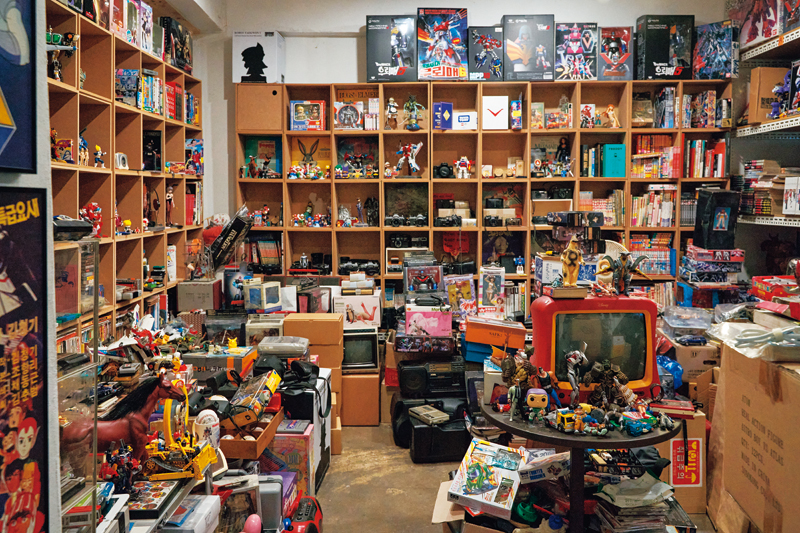
The commercial district surrounding Dongmyo Flea Market formed in the 1980s. The market trades assorted items such as second-hand clothes, antiques, used furniture, and old books. The photo shows a toy shop full of decades-old figurines and games, which attract young shoppers who embrace retro culture.
© Seoul Tourism Organization
Donggwanwangmyo is a shrine in central Seoul dedicated to Guan Yu, a famous general who helped pave the way for the Three Kingdoms period in China. Completed in 1601, it is commonly referred to as Dongmyo, and the current market emerged next to the shrine’s wall.
In the 1980s, a flea market formed and became the go-to place for used brand-name clothing, shoes, handbags, musical instruments, watches, and household goods. In the early 2000s, when the Cheonggyecheon restoration project displaced the merchants of the nearby Hwanghak-dong Flea Market, they flocked to Dongmyo, making it the biggest flea market in Seoul.
For a long time, the market’s key clientele were elderly shoppers, coming as much for the bargain prices as for the old-fashioned ambiance. Recently, however, Dongmyo has become a popular destination for younger customers who seek vintage fashion and accessories amid a potpourri of makeshift displays.
TONGIN MARKET
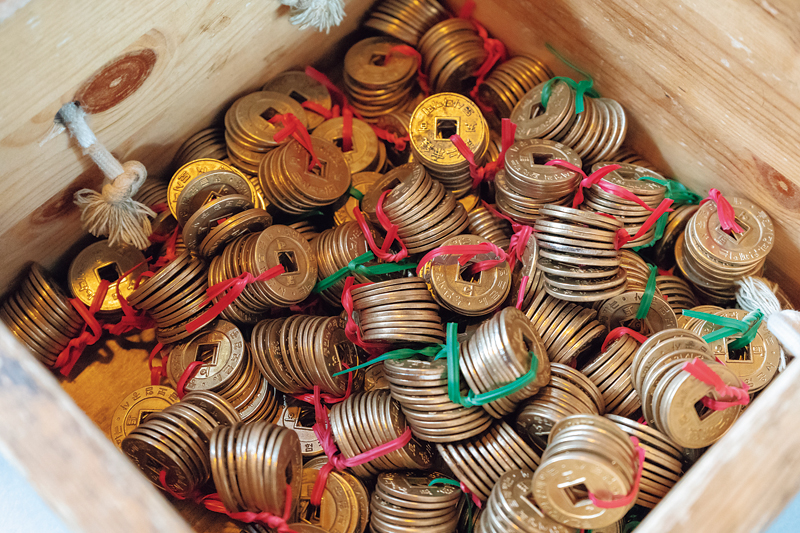
Tongin Market in Seochon, a residential area west of Gyeongbok Palace, is a typical alleyway market. There are scores of food vendors and other stores. Young visitors especially enjoy the innovative system of using yeopjeon, or brass coins, to pay for side dishes totheir own lunchbox.
© Korea Tourism Organization
Tongin Market is in a residential area near Gyeongbok Palace in Seoul. The market was set up in the early 1940s, and after the Korean War, the business of street vendors thrived here, as the population in the surrounding area increased rapidly.
The market is better known for its food stalls, restaurants, and grocery shops than its merchandise. It is famous for its innovative system that allows visitors to fill up their own dosirak, or lunch box. They first purchase brass coins (yeopjeon), which resemble currency used during the Joseon Dynasty. Then they can use the coins to buy small portions of food from the array of food vendors. This market specializes in two variations of tteokbokki, a quintessential street food usually consisting of rice cakes smothered in a sauce made with gochujang, or chili paste. At Tongin Market, visitors can enjoy gireum tteokbokki, for which rice cakes are seasoned with either red chili flakes or soy sauce, before being stir-fried in oil.
JAGALCHI MARKET
Jagalchi Market is the largest seafood market in Korea. It occupies the waterfront of the historic center of Busan, the country’s second-largest city and main maritime logistics hub, and offers a variety of fish, shellfish, and dried seafood. Inside the market, there are restaurants where patrons can enjoy the fresh catch of the day either raw, steamed, cooked, or grilled.
Although there is no exact record of when Jagalchi Market was formed, it originated when fishers set up makeshift beach stalls to sell the fish they had caught on their small boats. The market became permanent in the early 1920s and opened as an officially recognized market in 1972. It takes its current name, Jagalchi Market, from the abundance of pebbles, or jagal, which used to be found on the beach. The market, which is always bustling with activity, has become a popular subject among painters.
SEOMUN MARKET
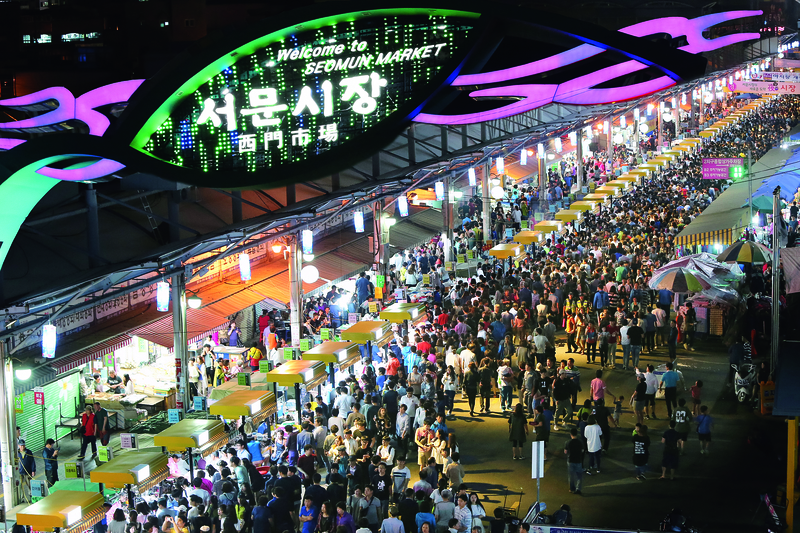
Seomun Market, in the southeastern city of Daegu, consists of around 4,000 stores and is known for its assortment of fabrics. In recent years, the Seomun Night Market, open on Fridays and weekends, has gained considerable popularity.
© Jung-gu Office, Daegu Metropolitan City
Seomun Market in Daegu, North Gyeongsang Province, was one of the three largest markets on the Korean peninsula, along with Pyeongyang Market and Ganggyeong Market in Seoul, during the late Joseon Dynasty. Initially a small five-day market, it developed into a large-scale operation, then called Daegu Market, following fiscal and administrative reforms in the latter half of the 17th century. After being relocated, it reopened in the early 1920s at its current location and was named after the west gate of the Daegu Fortress Wall, which had been demolished in 1907. Known for trading fabrics such as silk, hemp cloth, and cotton, Seomun Market is credited for having been a major contributor to the development of the domestic textile industry.
In recent years, the night market, which opened in 2016, has gained fame. With over 80 stalls lining a 350-meter street, it offers a variety of food and other goods, as well as different attractions such as live music and light shows. The night market scenery was featured in the TV series What’s Wrong with Secretary Kim (2018), which was based on a web novel of the same title.
Ji Geun-hwa Associate Editor of Koreana